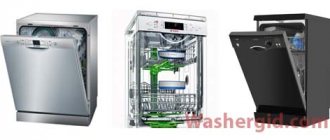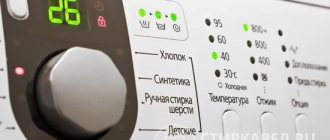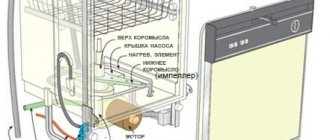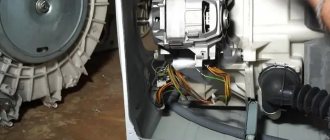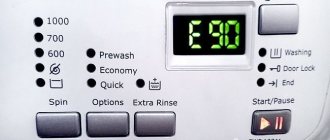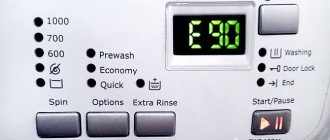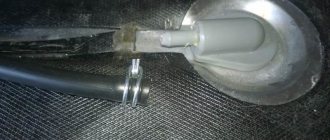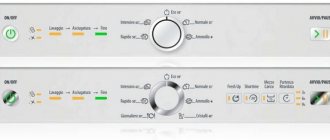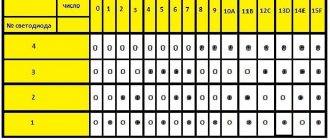Siemens brand equipment is known for its functionality and the introduction of the latest technologies. Therefore, if there is a problem, the electronics launches a self-diagnosis system. An error code appears on the display, which indicates the cause of the failure. But even if there is no code, malfunctions of the Siemens dishwasher are manifested by external signs. Why equipment breaks down and how to fix it yourself, read the publication.
Typical breakdowns and error codes of a Siemens dishwasher
The design and principle of operation of the Siemens PMM is practically no different from other models. But some problems are especially typical for this brand. If an error code appears on the display, look at the instructions. The manufacturer indicates the meaning of the icons. And if you want to find out the details of solving the problem, the article “Fault codes for Siemens dishwashers” will help.
Here are the most common ones:
- E1 - water does not enter the tank.
- E7 - drying does not work.
- E9/E10 - the machine operates without heating.
- E15 - the Aquastop leakage protection has activated.
- E21/E23/E24 - water does not leave the tank, problems with the drain pump.
- E27 - incorrect network voltage.
How can you determine what is broken in the dishwasher if the code does not light up on the display? To do this, pay attention to the external manifestations of the breakdown. What users most often contact the service center with:
- The machine draws water slowly, the program freezes in the middle of the cycle . The reason may be a clogged filler path or a malfunction of the solenoid valve.
- PMM does not wash dishes well . The main problem is blockage. It is also possible that the circulation pump may break down or due to operating errors.
- The drain doesn't work . The problem is a clogged filter and a blocked pump impeller. Pump failure requires replacement.
- The program is not selected, the equipment is turned off . Problem with the electronic module.
Some problems can be solved at home. Follow our instructions below.
The water does not heat up: causes and description of the problem
The main reasons why equipment stopped heating water normally:
| Crash | Description of the problem |
| The heater has burned out. | The design of the PMM includes a flow-through water heater or, more often, a heating element. Externally, the part resembles the one installed in washing machines, but works on the principle of an electric kettle. Due to hard water, over time it becomes covered with a thick layer of scale and fails. It is impossible to repair the part; it must be replaced with an original analogue. |
| The temperature sensor (sensor, thermostat) is broken. | The sensor is present in the design of any dishwasher. It is a sensor that determines the water temperature and reports the received data to the electronic board. If the process is disrupted, the command unit does not put the heating element into operation, and the machine washes the dishes without hot water. The thermostat cannot be repaired; it must be replaced. |
| The electronic control module is malfunctioning. | Electronic PMMs are equipped with a “brain” - an electronic board that analyzes information coming from various components of the device and issues commands to turn them on/off. If the machine stops heating water, it is possible that the module has failed and is not starting the heating element to work. You need to flash the electronic board or replace the unit with a new one. |
Siemens dishwasher errors
Siemens dishwashers are very popular among users because they are characterized by excellent functionality, high detail and interesting design, and thanks to the huge range and wide price range, the devices are available to every average buyer.
Despite decent build quality, users sometimes encounter functional failures, which are displayed on the displays in the form of incomprehensible ciphers and codes. It is possible to fix problems yourself if you familiarize yourself with the encoding values.
Error codes for machines with a display and their elimination
Almost every Siemens dishwasher is equipped with a self-diagnosis function, thanks to which the device immediately stops working if a malfunction occurs and signals this using a special code. To decipher and further eliminate a problem or malfunction, it is enough to understand the meaning of a particular error code.
To check how serious the breakdown is, or whether it is just a failure in the system, it is enough to reboot the household appliance, which consists of several steps:
- disconnect the equipment from the power supply;
- wait 20-30 minutes;
- connect the device to the power supply.
If after rebooting the code disappears, then you can continue to use the dishwasher as usual. If the error appears on the display again, you need to correctly decipher the code and try to fix the problem yourself.
So, below are the most common error codes that users of Siemens dishwashers encounter.
- E09 is a signal about a breakdown of the heating element (heater). This is typical for devices with flow-through heating elements. Part elements may fail as a result of a short circuit or burnout. To eliminate the breakdown, you need to replace the burnt out contacts or replace the heating element.
- E15 means that the Aquastop protection option has been activated , warning of leaks in the device. It is possible that water has been detected in the pan (200 ml is enough to accumulate). You need to find the leak and discharge the water manually or using improvised means. This may be the tank, the connection point of the drain or inlet hose, as well as the sealing rubber of the hopper door.
- E19 indicates a problem with the detergent compartment.
- E22 - this means that there are no contacts between the pump and the device module. It is necessary to diagnose the electronic control of the equipment, as well as check the serviceability of the pump itself.
- E24 means problems with drainage. There may be problems with the sewer system, the drain hose is clogged and needs cleaning, or there is a kink somewhere. There are special products for cleaning the hose and filters.
- E25 indicates an incorrect water draining process. The reason for this may be a simple clog in the filter or drain hose, or perhaps the drain pump is blocked, or the siphon is blocked. After a thorough cleaning, everything will be restored.
- E27 signals insufficient voltage in the electrical network. This sometimes happens in the evening when the network is overloaded. The optimal solution and prevention of this would be to install a voltage stabilizer.
Along with error codes on the display, users sometimes encounter the fact that during operation the indicator where the faucet is drawn turns on and lights up. This indicates insufficient water supply. There may be several reasons: the filter mesh is clogged, or the water supply solenoid valve has failed. To fix the problem, you need to clean the filters with a brush and also rinse the hose.
It also happens that the display flashes, but the unit does not start working. The reason for this may be improper closing of the door or a loose fit. In this case, the door lock may malfunction or the door sensor may fail.
If any problems or failures occur, there is an excellent help - instructions, as well as contacting the service center.
How to fix the problem yourself
Start diagnostics by checking the Aquastop mode. The sensor could be stuck in the pan. Also inspect the hoses and housing for leaks. If you do not find any external damage, then you should remove the dishwasher plug from the socket. Try tilting the technique from side to side so that the float returns to its original position. If water drains into the pan, remove it. Let the machine dry and only then resume work. Also pay attention to the external condition of the drain hose. When the mechanical protection is triggered, this part must be replaced with a new one.
Errors of machines without a screen
Users of Siemens dishwasher modules that are not equipped with an LED display also sometimes encounter various types of malfunctions and functional failures. It is possible to determine the type of breakdown and eliminate the causes only if the problem is correctly identified.
Here are the most common mistakes.
- The “Tap” LED lights up, which notifies you of poor water supply or a complete cessation of its supply. The reasons may be different: they forgot to open the water supply tap, the water hose is clogged, low pressure, the water level sensor has failed. In addition, if the hopper door is not closed tightly, the program will not start at all.
- The “Crane” indicator is flashing. This indicates a technical malfunction of the unit. To determine the problem, service testing will be required.
- The LED for the presence of special salt flickers, which indicates excessive scale or deposits on the heating element. A heating element with scale can negatively affect the functionality of the unit.
In addition, after a long period of operation, users sometimes observe intense flashing of all indicators at the same time, which is a sign of an improperly closed bin door. It is recommended to reset all configured settings and restart the machine.
If nothing has changed, then the reason may be a malfunction of the door lock, loss of interaction between the door sensor and the control system, which requires specialist intervention.
How to check and repair a temperature sensor and control board
The temperature sensor is a weak element in the design of a dishwasher, especially for Bosch brands. To understand that the temperature sensor has failed and not another part, proceed as follows:
- Arm yourself with tools: a tester (multimeter), screwdrivers and pliers.
- Disconnect the equipment from the water supply and sewer network (be sure to close the taps on the pipes themselves).
- Disconnect the electrical appliance.
- Remove the dish baskets.
- Remove the lower nozzle, the “garbage” filter and the mesh, unscrew the two fasteners that you will find under it.
- Turn the car upside down and remove the fastenings on the sides.
- Disconnect the drain pipe from the block in which the heating element is located and lift the bottom of the PMM upward.
- The sensor is located inside the body of the water heating unit - this design is due to the need to transfer data to the control unit.
- Disconnect the wires from the thermistor contacts.
- Clean the contacts and use a tester to measure the resistance level of the sensor.
- If it becomes clear that the element has burned out, do not install it back, but take it to the store to find a similar one.
- Install the new element in the same way as you removed it - all actions are carried out in reverse order.
Important! Often it is not the temperature sensor that is faulty, but its wiring. If everything is fine with the sensor (and heater), you should look for the problem in the electronic module.
In 1 case out of 100, it happens that the heater is working properly (according to the tester), everything is fine with the sensor and the wiring is in order. Checking the system for blockages showed that everything is fine, the pressure is normal, and the machine continues to wash with cold water. What is the reason, what should I do? In this case, there is a high probability of failure of the electronic unit: most likely, not all at once, but a separate part - the triac.
We do not recommend repairing an expensive part yourself. Repairing a board requires electronics knowledge, experience, and special tools. If it fails, you will have to buy a new module, and its cost is often up to half the price of the PMM.
When is professional repair necessary?
If all attempts to independently diagnose a malfunction of a Siemens dishwasher are in vain, you will need the help of a specialist. Contacting a service center or technician is necessary when:
- error code E01 appears on the screen, indicating a breakdown of the electronic control unit;
- code E2 or E02 is displayed, which indicates serious problems with water heating;
- Code E6 appears, which indicates a breakdown of the aquasensor that monitors water quality and hardness.
Sometimes serious damage may be indicated by intense flashing of all indicators at the same time or by the detergent replenishment lamp. You should not carry out repairs on items such as the drain pump, electronic board and motor yourself.
What repairs will a machine that does not heat water need?
The type, nature, and cost of repairs depend on the unit that has failed. You may need:
- reinstallation of the dishwasher;
- flashing or replacing the control unit;
- repair or replacement of heating elements;
- replacing the thermostat;
- installation of a new pressure sensor.
Repairing components in modern Siemens dishwashers is not easy. Most often they are replaced with new ones. Therefore, you will have to pay not only for the services of the master, but also for new parts. The most expensive repair will be if the heating element fails. Reinstallation, replacement of the thermostat or pressure sensor will not be very expensive.
Source
Recommendations
In order for the Siemens dishwasher module to serve for a long time and efficiently, it is necessary to use the device for its intended purpose, not to overload it, not to use adapters and extension cords when connecting it to the network, and also to ensure proper care. Here are the basic rules.
- Regular ventilation of the bunker. After each wash cycle, leave the appliance with the door open to dry.
- Control of detergents and auxiliary products. Rinse aid and salt should always be present in the compartments of the dishwasher, as these products prevent the formation of scale and white deposits on the parts of the unit.
- Cleaning all filters. The dishwasher is not a waste disposal unit, so small food residues accumulate, overloading the filtration system. The drainage system must be cleaned every 6 months.
- Periodic washing of the machine. Once a month it is necessary to wash the device using special products.
Proper operation of the dishwashing unit will reduce the likelihood of its failure tenfold.
See below for Siemens dishwasher errors.
If you liked the article, please share it
Previously on the topic:
Share
Dishwasher error codes
Alarm about malfunctions, self-diagnosis of electrical and hardware circuits - error codes for dishwashers. Over the past 6-7 years, manufacturers have been introducing dishwashers into the mass segment. A partial list can be found in the instruction manual. The table from the manual describes the encoding associated with minor and easily fixable problems - you can fix it yourself. The functionality of fixing a dishwasher with your own hands, according to the manufacturer, comes down to three areas:
- does not turn on - socket, insert the plug into the network
- does not take in water - water tap, inlet strainer
- does not drain - there is a foreign object or food debris in the filters, pump, the siphon under the sink or the check valve is clogged.
Point 3 can be easily accomplished only with PMMs from the BOSCH group; the rest do not provide easy access to the pump.
For other dishwasher signals, contact a Good Master. Information on videos and forums is always silent about the subtleties, and that’s the whole point. Error E15 Bosch dishwasher is a classic example.
Common problems and coding are described below.
